|
Origin of the LESS Initiative
In October, 1997, SETMA attended the Medical Group Management Association meeting to preview electronic-health-record (EHR) solutions. In March, 1998, SETMA signed a contract with NextGen to purchase their EHR and their EPM (enterprise practice management system). We deployed the EPM side of the system in August, 1998 and the EHR on January 26, 1999. By Friday, January 29th, we documented every patient encounter in the EHR. In May, 1999, three seminal events transformed SETMA’s healthcare vision and delivery.
The first event led to the LESS. We concluded that EHR was too hard and too expensive if all we gained was the ability to document an encounter electronically. EHR was only “worth it,” if we leveraged electronics to improve care for each patient; to eliminate errors which were dangerous to the health of our patients; and, if we could develop electronic functionalities for improving the health and the care of our patients. We also recognized that healthcare costs were out of control and that EHR could help decrease that cost while improving care. Therefore, we began designing disease-management and population-health tools, which included “follow-up documents,” allowing SETMA providers to summarize patients’ healthcare goals with personalized steps of action through which to meet those goals. We transformed our vision from how many x-rays and lab tests were done and how many patients were seen, to measurable standards of excellence of care and to actions for the reducing of the cost of care. We learned that excellence and expensive are not synonyms.
After developing, several disease management tools, we realized that in the plan of care for each, we identified three life-style changes which we wanted everyone to make. One of them was to stop smoking. Whether it was for diabetes, cholesterol, hypertension or others, it was critical that our patients decrease the inflammatory burden on their cardiovascular systems by avoiding primary, secondary and now tertiary tobacco products. We want patients to decrease their risk by losing weight and to increase their cardiovascular health with routine, regular aerobic exercise, strengthening and stretching exercise.
To address these issues with one patient is not problem, but how to do it with 400+ patients a day and how to know that you are doing it, is a different matter. As a result we designed the LESS Initiative (Lose weight, exercise, stop smoking). The program included a diabetes risk assessment, a diabetes screening assessment and a hypertension prevention program.
This tutorial explains the LESS and other tutorials explain the Diabetes and Hypertension Prevention programs. Those can be found on the web site under Prevention Tools, also.
The premiere primary preventive health initiative of SETMA is the LESS Initiative. LESS is an acronym for: lose weight, exercise, and stop smoking. Included in the LESS Initiative are diabetes prevention, hypertension prevention and insulin resistance risk analyses. The following procedure is the proper way to complete the LESS Initiative.
The LESS Initiative contains the following templates, pop-ups and links:
- At the top of the AAA Home Template there are three hyperlinks:
- The LESS Initiative hyperlink launches the Less Initiative.
- The Diabetes Prevention hyperlink launches an analysis of diabetes screening with eight pop-ups which will be explained below
- Hypertension Prevention hyperlink
- Completed properly and explained to the patient properly, the LESS Initiative is an effective tool in SETMA’s commitment to excellent in the care of our patients.
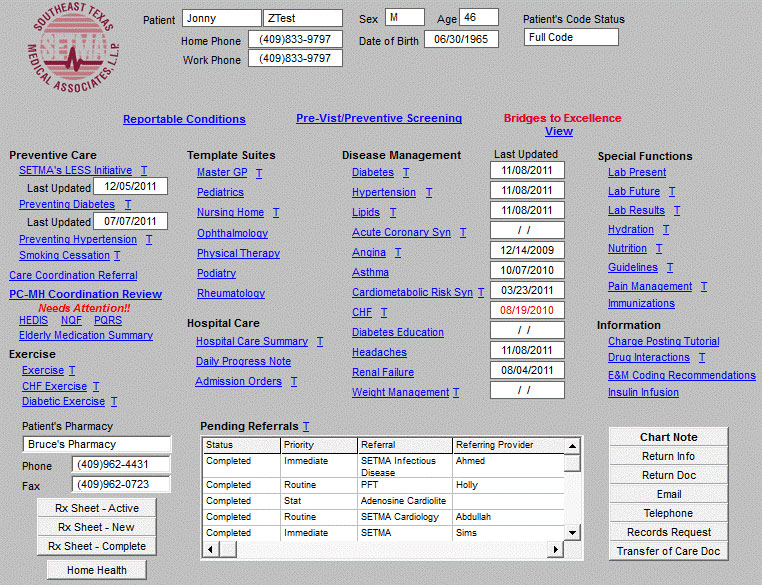
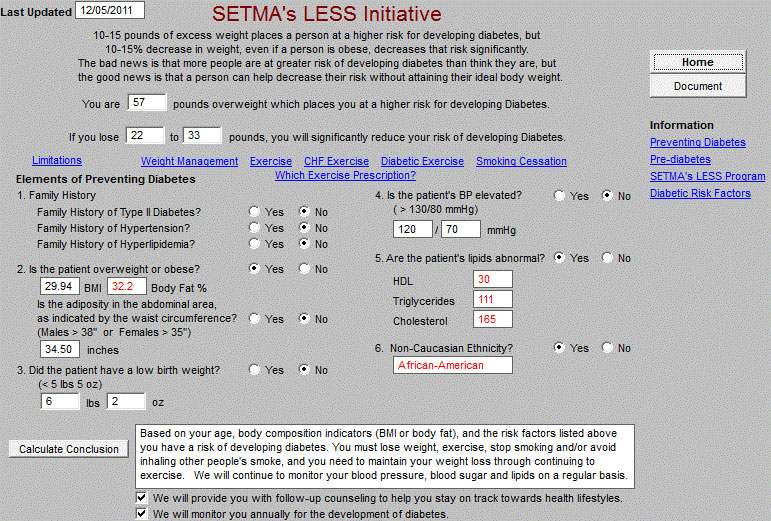
LESS Initiative Template
- When the LESS Initiative hyperlink is single clicked, if the patient's vital signs have not been completed (particularly blood pressure and pulse), a pop-up will appear which states, "The patient's vitals signs must be completed before proceeding to the LESS template."

You will automatically be taken to the Vital Signs template.

Once the vital signs have been completed including the patient's:
- Blood pressure
- Pulse
- Respiratory rate
- height,
- weight,
- percent body fat,
- abdomen
- waist,
- hips and
- chest
- BMR
- pulse oximeter (if indicated)
- Glucose (if indicated)
- Tidal volume (if indicated)
you are ready to complete the LESS Initiative by single clicking the return button on the vital signs template and then single click the "LESS Initiative" hyperlink again (note: at this point a pop up will appear reminding you to ask the patient about their tobacco use)
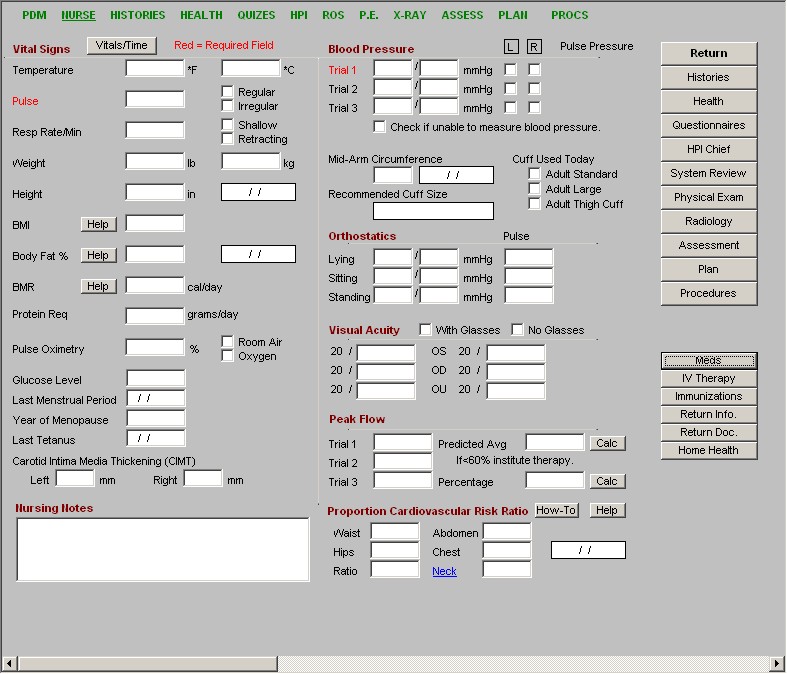
- remember, all but the patient's weight, blood pressure and pulse are in demographic fields, which means that once they are done, they will copy forward in subsequent visits and only need to be repeated if the patient loses or gains a significant amount of weight, or gains or loses height. Of course, the glucose, pulse oximeter, and tidal volume values are not carried forward to subsequent visits either.
- If the patient has had the LESS Initiative completed within the past two months, a pop-up will appear which will indicate that the patient has had this material given to them in that time frame and it is not necessary to do it again at this time. It is permissible and perhaps ideal to give it to the patient again, but it is not required.

- The LESS Initiative template is divided into four parts:
- At the top is a statement about the contribution which excess weight makes to diabetes risk and the benefit of weight loss to the decreasing of that risk. When the Weight Management Assessment is access (see below), numbers will be added to the blank spaces indicating how much overweight the patient is and how much weight they need to lose in order to reduce their risk of developing diabetes.
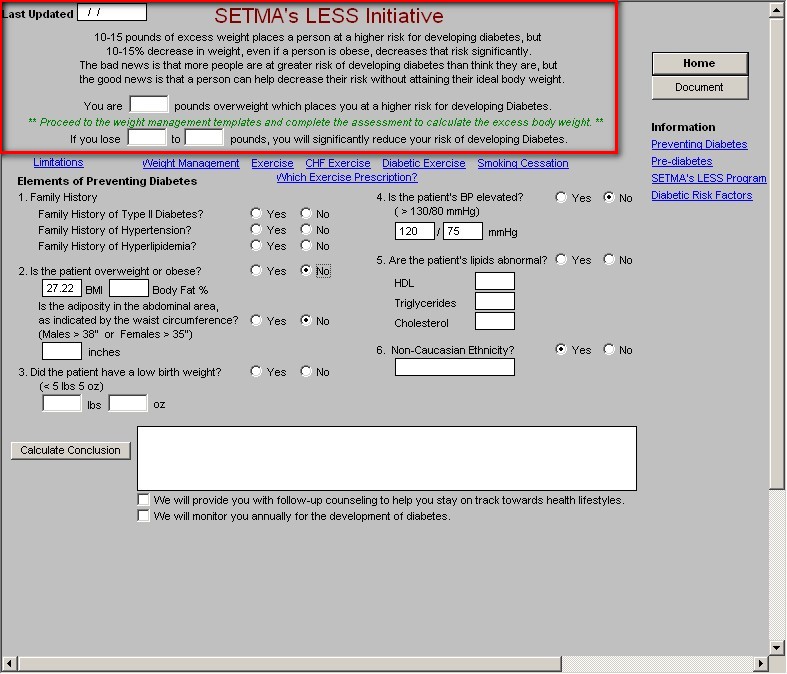
- The second part of the LESS template contains six hyperlinks:
- Limitations - this hyperlink launches a pop-up which allows for the notation that the patient either "refused to be weighed" or "could not be weighed."
- Weight Management - this launches the Weight Management Assessment template
- Exercise - this launches the Exercise template
- CHF Exercise - this launches the CHF Exercise template
- Diabetes Exercise - this launches the Diabetes Exercise template
- Smoking Cessation - this launches the Smoking Cessation template.
- Details of these six hyperlinks will be given below.
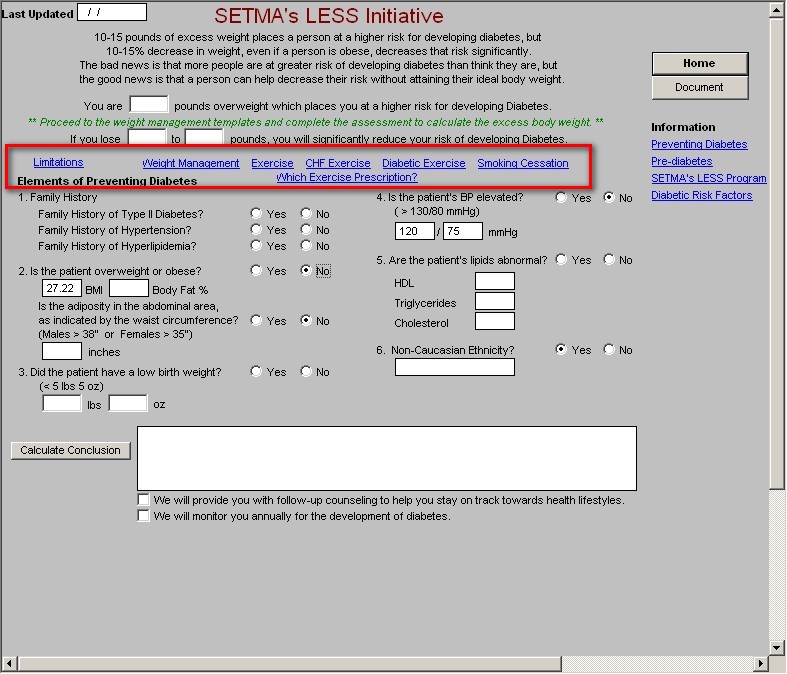
- The third part of the LESS template contains the risk factors for the development of diabetes. There are six for males and seven for females. These are automatically noted. Under the following circumstances;
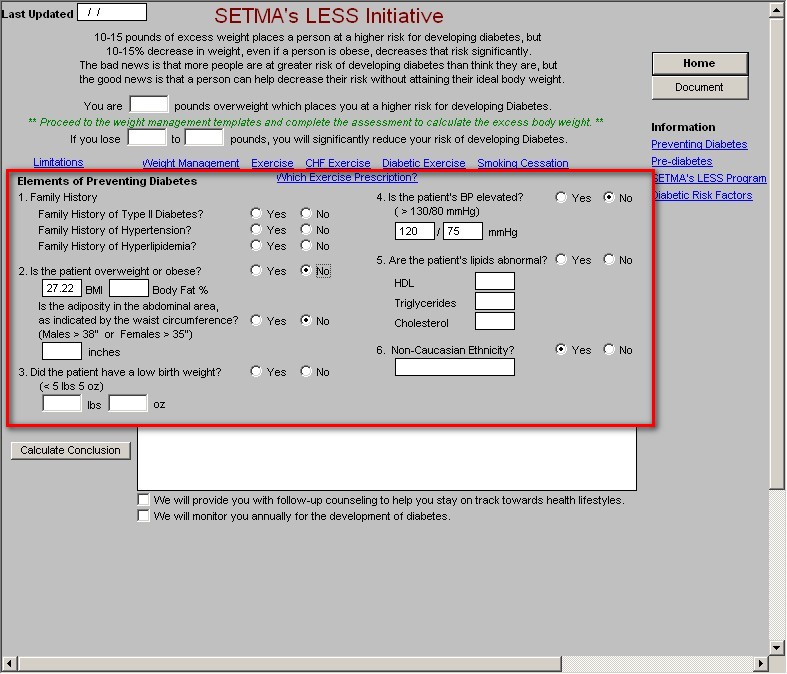
On the History Template, there is an "Ext Fam Hx" (Extended family history) button at the bottom of the template. On this template, there are check boxes for noting whether the patient has a family history of Diabetes II, Other Endocrine disorders, Hypertension, Lipid abnormalities.
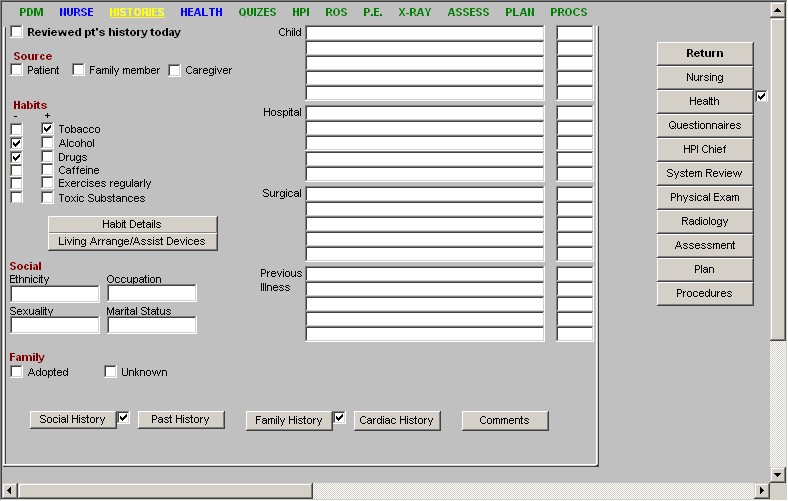
If this function has been completed, it will automatically populate this section of the LESS Initiative.
We do not capture the information for questions number three (birth weight), or number seven (gestational diabetes, only for females obviously), therefore these two pieces of information need to be added. These two data points are in demographic fields so if they are added, in that they never change, they will always copy forward.
- The fourth part of the LESS template is the Calculate Conclusion button, which analyzes all of the information above and determines whether the patient has a high or a low risk of developing diabetes. In order for this to be completed it is necessary to click on the Calculate Conclusion button.
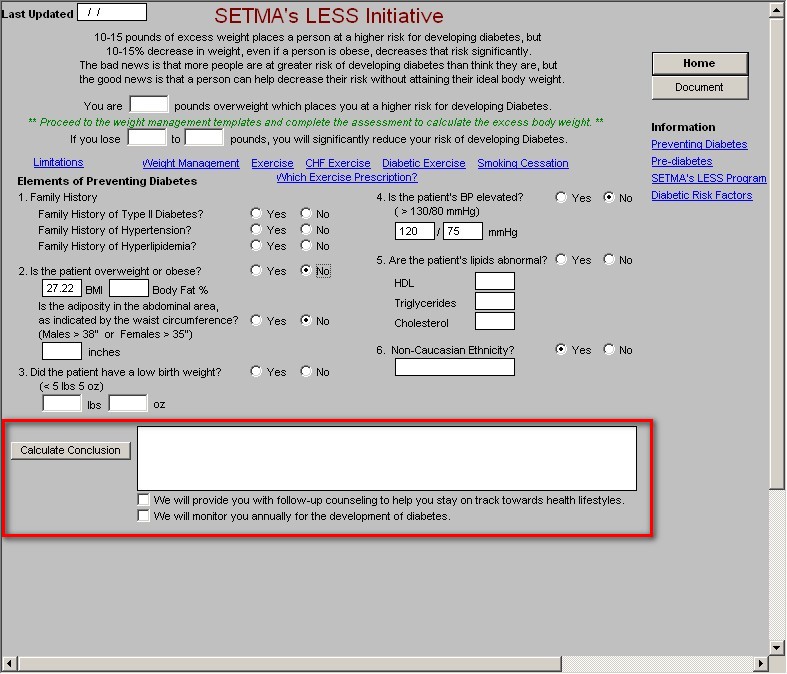
Successfully completing the LESS Initiative: The Six hyperlinks on the second part of the template.
- Limitations hyperlink is the first hyperlink which is explained above. If an option is checked, it excuses the completion of the weight management part of the LESS, but the Exercise and the Smoking Cessation should be completed.
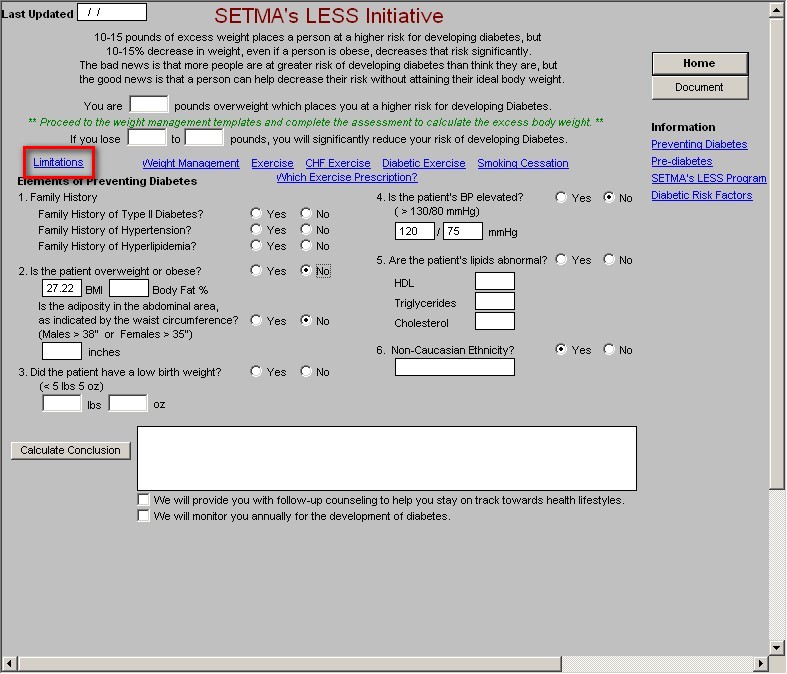
- Weight Management hyperlink is the second hyperlink, which accesses the Weight Management templates. In order to properly complete this part of the LESS, the three "calculate" buttons in the third column must be checked. Then click return, which will take you back to the LESS Template.
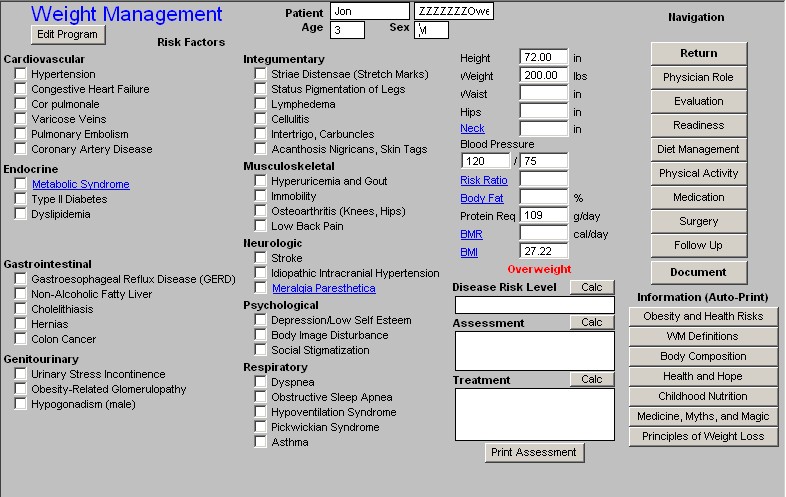
- Exercise hyperlink is next.
- Note: It is necessary and appropriate only to complete one form of exercise prescription, not all three.
- If you complete the standard Exercise prescription which is this one, do not complete the other two.
- If the patient has CHF or physical limitations, complete only the CHF Exercise prescription.
- If the patient has diabetes, complete only the diabetes exercise prescription.
- If you inadvertently complete more than one Exercise prescription, in order to make sure that only one of them prints, click the hyperlink entitled "Which Exercise Prescription?," which is just below the Exercise/CHF Exercise hyperlinks and only the one you check in the pop-up will print on your LESS Initiative document which you will give to the patient.

To properly complete the Exercise Prescription, click on Exercise:
- If the patient is currently exercising, complete the type, speed, duration and frequency of their exercise. Then click "calculate."
- This will calculate how many aerobic points they are getting each week. The standard is that they should get at least 27 a week for females and 32 for males.
- Then click on "running/walking/jogging," then click the calculate button. This will place on the exercise prescription a minimal goal for the patient to reach. Then click return which will take you back to the front page.
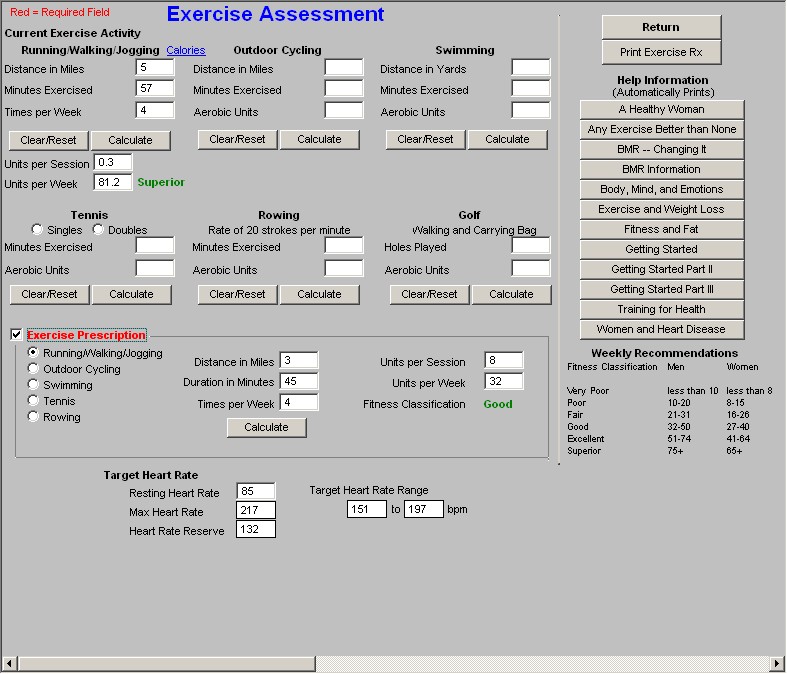
- CHF Exercise hyperlink is next. If you have completed the Exercise prescription and if the patient is not severely limited, then skip this hyperlink. If the patient has serious limitations and/or has CHF, complete this exercise prescription as follows.
- Click on the CHF Exercise hyperlink
- Click on the Exercise Prescription hyperlink which appears on the CHF Exercise template. This creates the CHF exercise prescription document which will appear on the LESS Initiative Document.

- Diabetes Exercise hyperlink is next. Once again, if you have completed either the Exercise or the CHF Exercise template do not complete this one. If the patient is a long-standing diabetic with complications, use this template.
- This is the most complex of all of the Exercise prescriptions. However, even in its complexity, it is relatively easy to use. If you follow the hyperlinks down the left hand side of the template it will guide you.

- The first column is entitled "Possible Contraindications to Exercise," under which there are four categories:
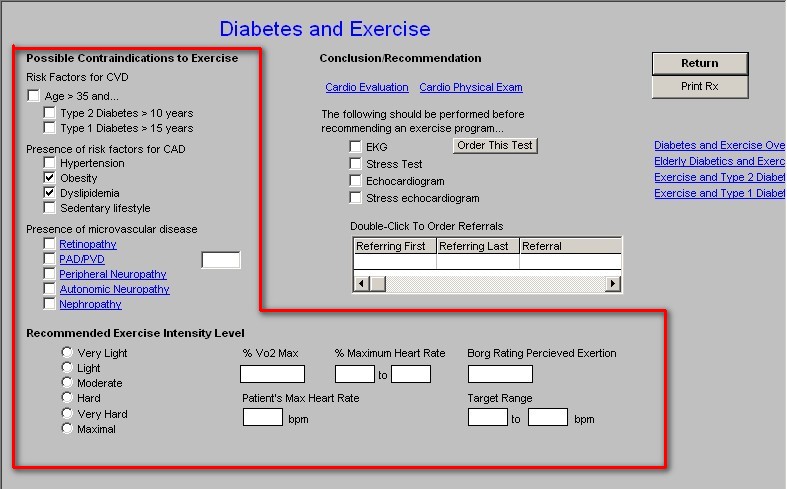
- Risk Factors for Cardiovascular Disease
- Presence of Risk Factors for CAD
- Presence of Microvascular Disease – There are five conditions under this heading. They are:
- Retinopathy
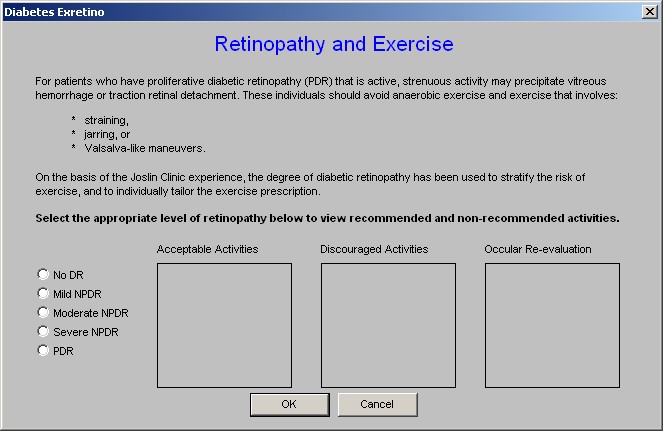
- PAD/PVD
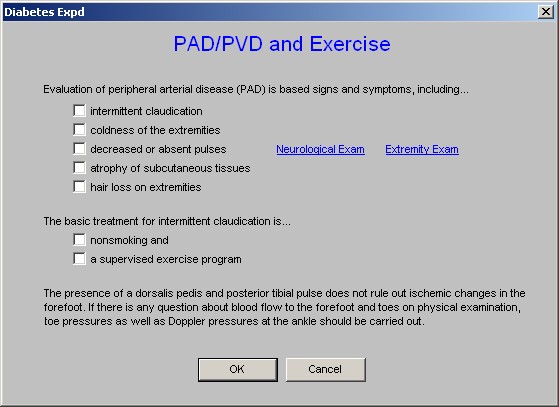
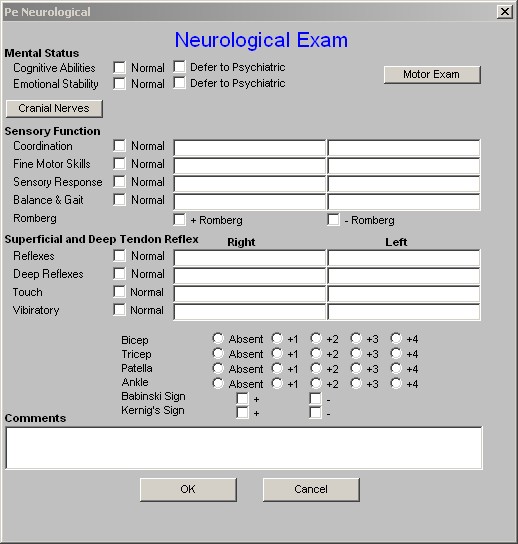
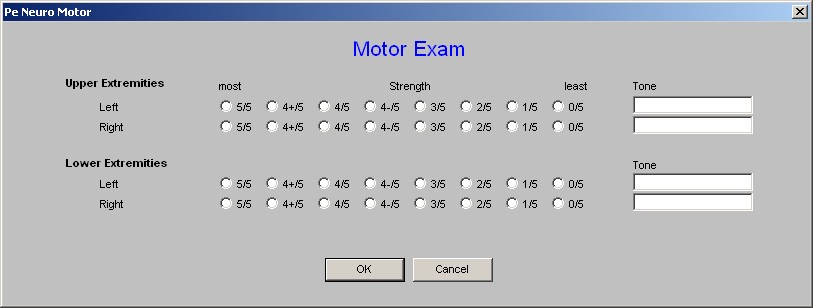
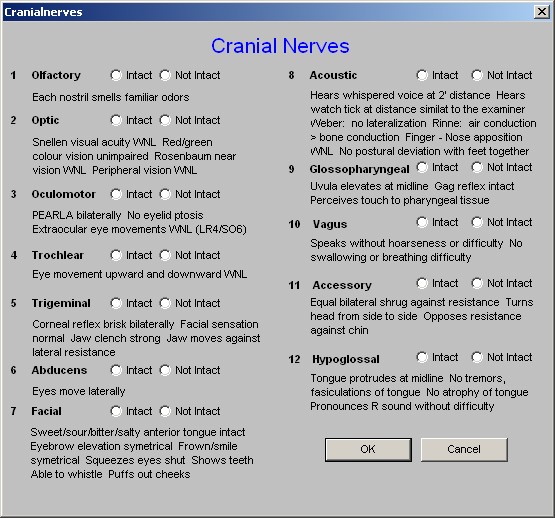
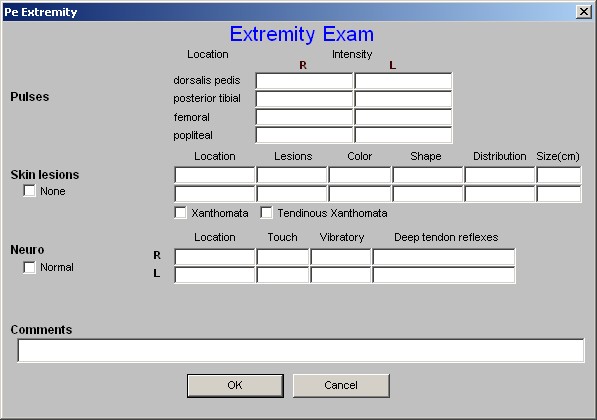
- Peripheral Neuropathy
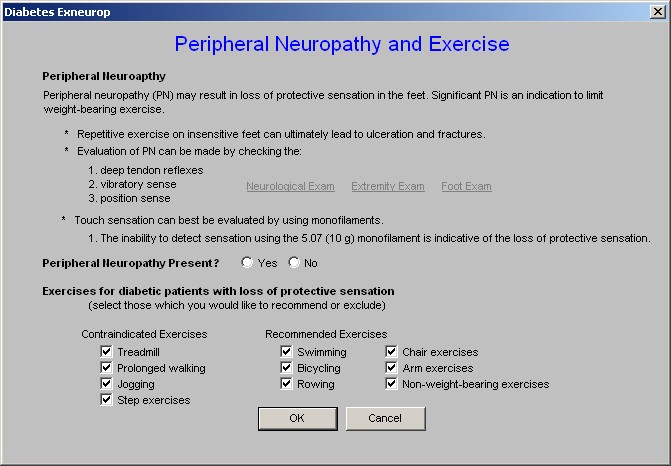
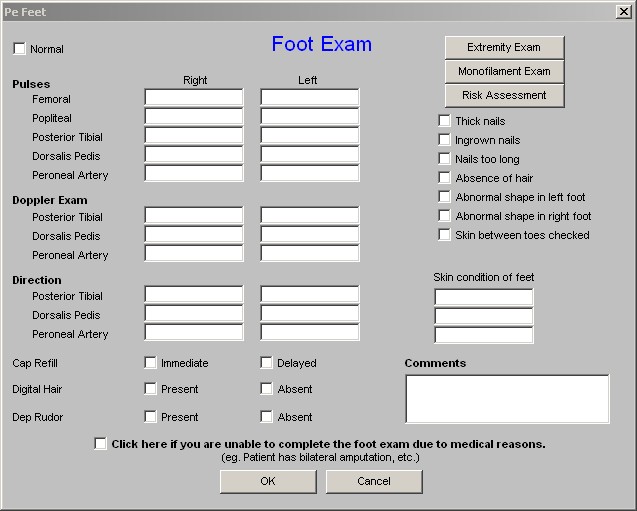
- Autonomic Neuropathy
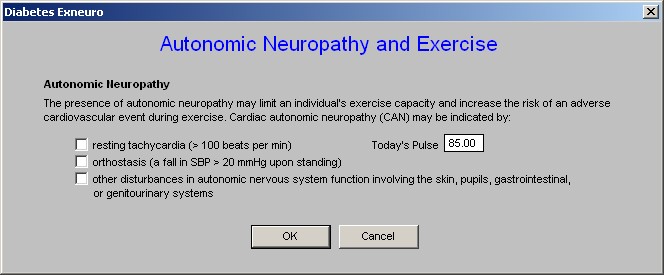
- Nephropathy
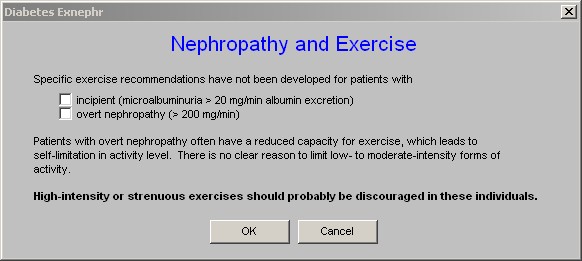
On the Diabetes Disease Management Templates, the eighth button down on the right is entitled "Complications/Education."
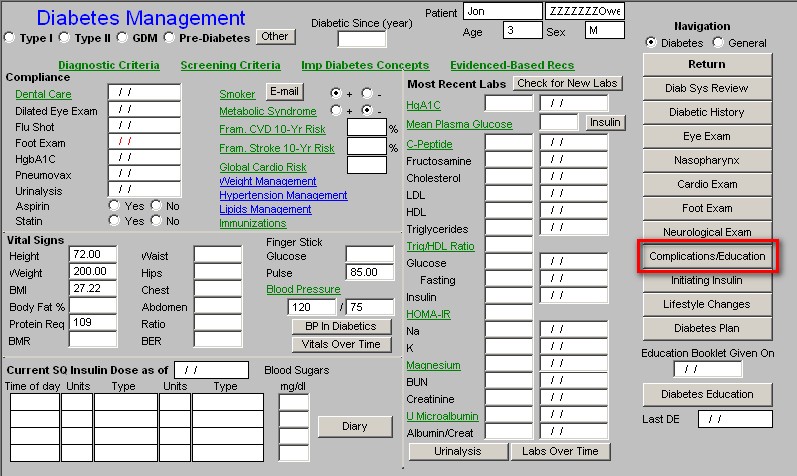
If the diabetic complications were documented there, they will automatically note which of the five categories of complications are positive in this patient. You will then be able to click on that hyperlink and assess how that particular complication limits the physical activity of this patient.
- Recommended Exercise Intensity – based on the recommendations from the result of the first three sections of the Diabetes Exercise Templates, you will select an intensity of exercise, which will then add the following to the patient’s exercise prescription:
- %VO2Max
- %Maximum Heart Rate
- Borg Perceived Exertion – the exercise prescription will explain this concept and how to use it.
- Patient’s Maximum Heart Rate
- Target Heart Rate Range
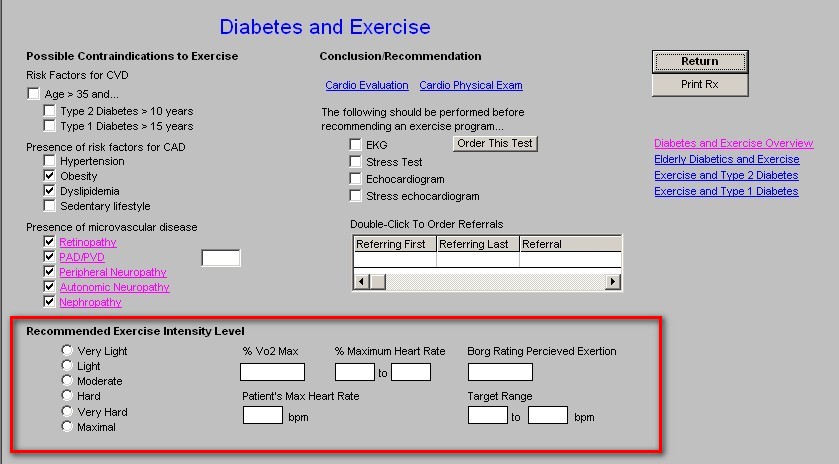
- Then click on the button labeled Print Rx. This will make all of the Diabetes Exercise Prescription material print on the LESS Initiative document.
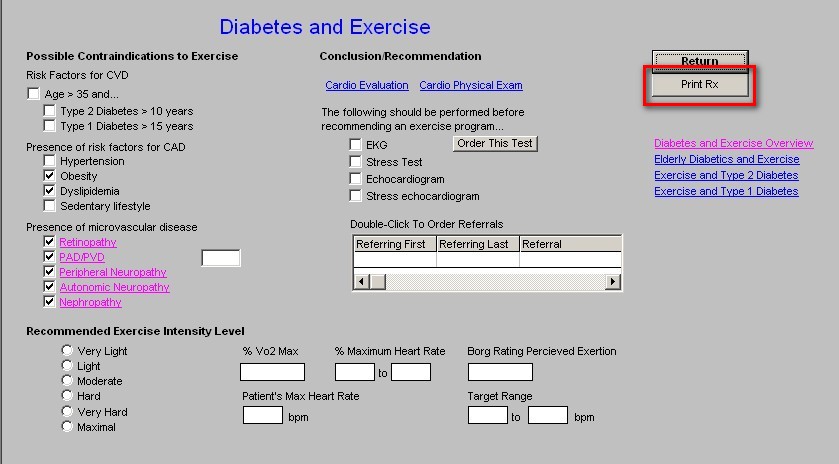
- There are several other features on the Diabetes Exercise Template, which are:
- Conclusion and Recommendation – often, before a diabetic should exercise, certain testing should be obtained.

- The appropriate tests and/or referrals can be ordered from this template.
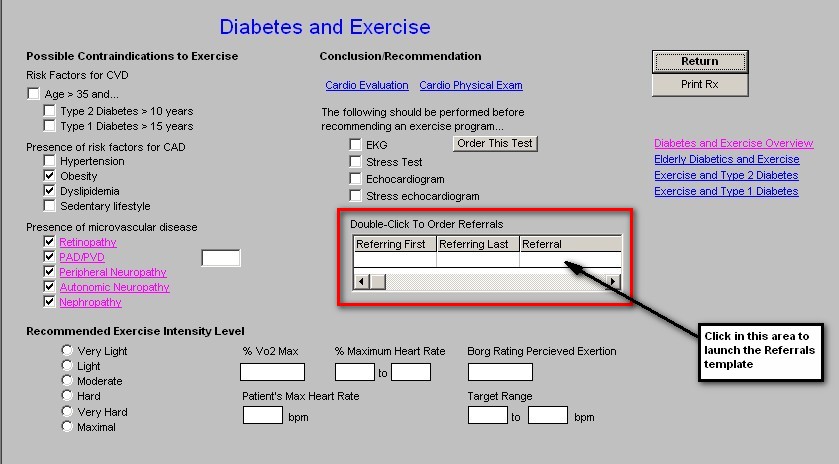
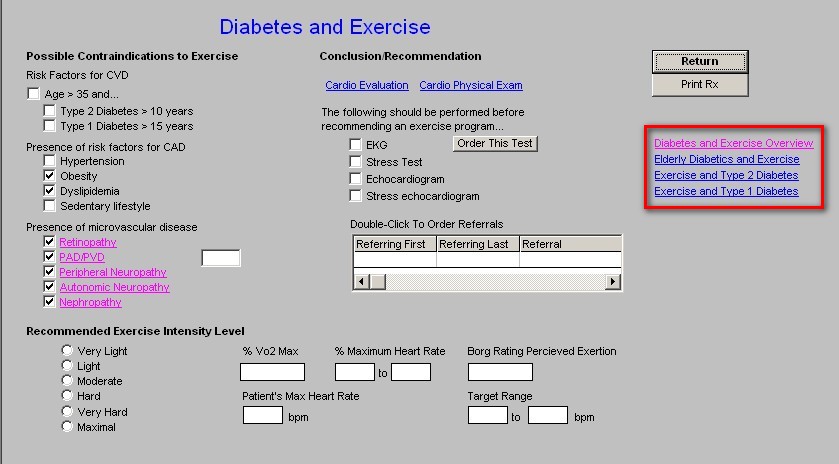
Click here to learn How to Complete a Referral
- Also, there are four documents on this template concerning diabetes and exercise.

- Then click on "Return" to take you back to the LESS Initiative Template.

- Smoking Cessation – this is the sixth hyperlink
- Every patient must be confronted about whether they smoke and/or whether they are exposed to second hand smoke (also called environmental or side-stream smoke)
- The first section of this template involves smoking and environmental smoke.
- There are five questions on each of these subjects in two columns.
- All questions must be answered.
- The second section consists of four steps of action to help the patient make the decision to stop smoking.
- Ask
- Advise
- Assess
- Assist
- The third section of this template is entitled "Arrange Follow-up"
- Function to establish an electronic tickler file is present
- Send your unit clerk and yourself an e-mail by clicking on the hyperlink "email tickler file."
- Follow the instructions for sending the e-mail and delaying the delivery for one month.

- If the patient requires pharmacological treatment for smoking cessation, and most will, the provider can access the information on the drugs used in smoking cessation by clicking on the "Pharmacotherapy" button to the right of the template.
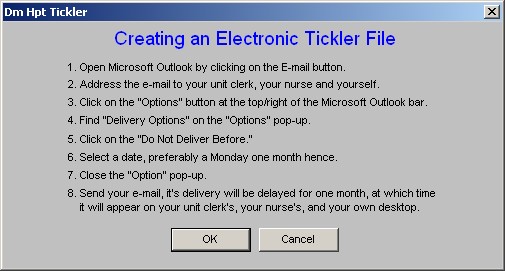
- Once you have done the e-mail tickler file, click on return.

Conclusion
- When you are back at the LESS Initiative Template, click the button entitled "document," which is the second button in the right hand column on the template.
- This creates a document which will contain:
- All of the material on the LESS template
- All of the material on the Weight Management Assessment
- All of the material on the Exercise Prescription which you chose
- All of the appropriate material from the Smoking Cessation template, if any.
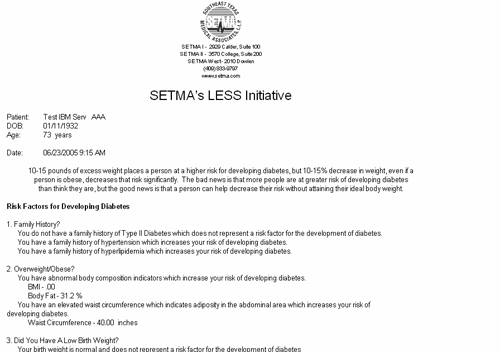
- This document automatically prints to your default printer.
Explaining the LESS Initiative to your patient
- Now that you have this wealth of information in your hands, you need to get it to the patient.
- If you simply hand it to them, most will not read it, but if you introduce it and then if you follow-up at your next visit and ask if they understood the material, you will increase its usefulness.
- Here is a suggested introduction of the LESS Initiative to your patient:
- "This is SETMA's LESS Initiative. We give this to every patient we see. LESS stands for "lose weight, exercise and stop smoking and/or avoid second-hand smoke." No matter what your age or health, these are the three most important things you can do for yourself.
Please read this. Ask your healthcare provider why this is important; he/she will be happy to discuss this with you. And, the next time I see you, I would like to know if you have been successful in losing weight, exercising and avoiding tobacco smoke."
|